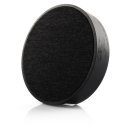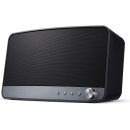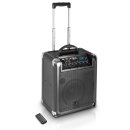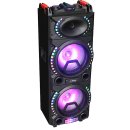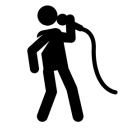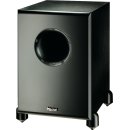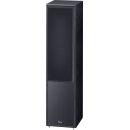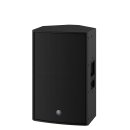Speakers
Here you will find our large selection of speakers for both "high and low" use - for professional users we have PA speakers and for the slightly practiced vocalists we have several types of vocal systems. Please contact us for advice and guidance on buying a speaker.
Speakers
Here you will find our wide range of active and passive speakers. At SoundStoreXL.com you can buy PA speakers for both private and professional use. We specialize in speakers for performers, either in the form of discos, recording studios or stages with fixed installations. Or for mobile performers, where speakers need to be solid, with a built-in amplifier - so-called active speakers - and easy to transport.
We also have many great speaker sets for bars, restaurants, cafés, gyms, sports halls, shops, showrooms, exhibition stands, or a private living room that just needs to be played properly.
Facts about systems and speakers
- A PA system is a collection of electronic audio equipment containing speakers, amplifiers, and microphones.
- You can use a PA system for music if you add a mixing console.
- PA stands for Public Address, as the system is optimal for making announcements to a large group of people at the same time in the first place.
Should I choose active or passive speakers?
When investing in speakers, it's important to decide whether they should be active or passive. The choice is primarily a question of what you want to use them for and how much they can cost. Here's how to understand the difference between active and passive speakers.
Passive speakers
The majority of speakers are passive. These do not have a built-in amplifier and therefore need to be paired with an external source to get power. This can be done by connecting one external amplifier through a speaker cable. The advantage of this is that you don't have to replace all the speakers if there are problems with the amplifier. At the same time, you have plenty of opportunities to swap around and try different equipment.
Active speakers speakers
Conversely, active speakers have a built-in amplifier. This is precisely matched to the speaker unit and fits with various frequency ranges. Active speakers need a signal cable and a power cable, but other than that, you don't have to worry about cables degrading the sound. If you're going on different jobs, it's nice to have an active system as there are generally fewer boxes, fewer cables, less weight and it's quicker to set up.
With most pro sound systems, the subwoofer is the only active component, so there is no practical reason for the rest of the speakers to be active. Active speakers reduce your ability to choose other amplifiers and are generally more expensive than passive speakers.
As you can see, there are pros and cons to both types of speakers. To say one is better than the other would be wrong. It depends on your technical needs and the capabilities of the speakers.
What should I be aware of when buying new speakers?
Speakers and PA systems come in many sizes and price ranges. It is therefore important that you first consider what you will be using your speaker system for.
Whether the speakers sound good is of course the first thing you consider. But this is usually not where you should spend your time and concentration. All the speakers in our range are made to an excellent quality that provides good sound. Instead, you should check if the sound level is strong enough for your use.
Checklist for buying a professional speaker system
As mentioned above, choosing your new speaker system is all about what you need it for. But here's a checklist of things to consider before your next purchase:
- Sound level: Is the system powerful enough for your use?
- Physical size and weight: how portable do you need the equipment to be?
- Ease: How easy does the system need to be to set up?
- Robustness: Can it stand up to your use?
- Flexibility: Can you add parts and try different equipment?
Taking the above into consideration will ensure you find a system that's right for you.
Types of speakers
There are a number of different types of speakers, all of which meet different needs. So once you know your needs, you can dive into the range of different types of speakers:
Wireless speakers
Wireless speakers are one of the most popular types of speakers in the modern world - and for good reason. The whole idea of being able to move a speaker around without a lot of wiring and sorting is a great idea and is therefore used by many people today.
We don't have to go back too many years before it was standard for a speaker to need a fixed power supply and/or connection to an amplifier or similar. Unless you're using your speakers for a turntable, for example, it's almost a requirement today that the speaker can also work wirelessly.
Wireless speakers - just like regular speakers - also come in a lot of different types to meet different needs. Festival speakers, a small functional speaker for the beach and a stationary, stylish and modern speaker for the home. It's easy to find the speaker that meets your needs.
Festival speakers
This genre of speakers is more recent and especially after the Danish company "Soundboks" saw the light of day, the term "festival speakers" became a regular part of the assortment of most speaker providers.
A festival speaker is typically a speaker with a lot of bottom end (bass), the ability to connect a microphone, a powerful battery, lots of volume and some handles of a shape to easily transport it. Regardless of which festival speaker you need, it's hard to get around the fact that all this technology weighs a bit.
Another common feature of festival speakers is that they are often very robust. They can take a beating and this is of course also essential when they are used at festivals and parties in general.
Party speakers
More general party speakers are characterized by being a bit more stationary and thus a bit less handy than, for example, festival speakers. However, they can live up to virtually any kind of party; student parties, garden parties, you name it!
A really cool party speaker also comes with a little light in it, so it also adds a festive element. If you have a little DJ in your stomach, there are even party speakers with a little built-in dj desk at the top of the speaker.
Bookshelf speakers
Bookshelf speakers are probably the most well-known type of speaker, but also the one most people simply refer to as "speakers".
While a set of floorstanding speakers are typically where you get the thickest sound, not everyone has the space for such large speakers or finds them particularly charming. Bookshelf speakers are just below that level. You still get a lot of sound from them, but they're just a little easier to have around the house.
Our audio geeks with more than 25 years of experience have handpicked our selection of speakers in this category to cover a wide range of needs. So we're sure you'll find something to suit your needs and tonal preference.
Floorstanding speakers
A floorstander is potentially one of the biggest clichÈs when it comes to male/female conflict. References to whether the man can bring his big speakers into the home are an old classic.
Whether you're a fan of floorstanding speakers or not, a floorstanding speaker can be the solution to getting both great sound and the style in your home you dream of. You often get a huge amount of sound for your money and they can be connected to turntables, tv and media players. This category has also been carefully selected by our great sound nerds in the company.
PA speakers
PA speakers are a slightly different size than "home" speakers. A PA speaker is designed to convey speech and sound to a large number of people. Therefore, they are most often used in connection with festivals, conferences, venues, bars, etc.
A PA speaker is most often used as either a passive or active speaker. You can read more about the difference here.
Speakers with a purpose
We always strive to ensure that our range can fulfill all the purposes our customers may have for their speakers. Therefore, here are some common pairings that we see from our customers.
Speakers with bluetooth
Many people prefer to have a speaker with Bluetooth so they can easily connect their mobile device to the speakers and play their favorite music from there. Luckily, Bluetooth is almost a standard for most speakers today, but it's a need we fulfill nonetheless.
Here are 3 speakers with Bluetooth that we recommend:
- WE. Hear 2 Bluetooth Speaker
- Tivoli Audio PAL+Bluetooth+DAB Speaker
- Ibiza WPORT10-300 "All Weather" Festival Speaker



